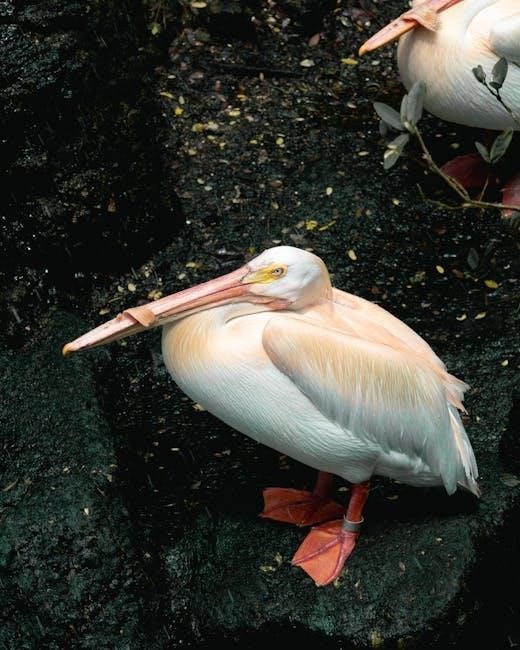Welcome to the Rain Bird WR2 Manual, your comprehensive guide to installing, programming, and maintaining the WR2 Wireless Rain Sensor․ This manual ensures proper setup and optimal performance for efficient water management in irrigation systems․
Overview of the Rain Bird WR2 Wireless Rain Sensor
The Rain Bird WR2 Wireless Rain Sensor is a cutting-edge device designed to enhance irrigation systems by detecting rain and freezing conditions․ It prevents unnecessary watering, conserving water and protecting landscapes․ Compatible with Rain Bird controllers, the WR2 integrates seamlessly into smart irrigation setups, offering wireless communication for effortless monitoring․ Its sleek design and user-friendly interface make it a reliable choice for both residential and commercial applications․ The sensor ensures efficient water management by automatically adjusting irrigation schedules based on real-time weather data․ With the WR2, users can enjoy precise control over their irrigation systems, promoting water conservation and system efficiency․
Importance of Using the WR2 Manual for Proper Installation and Operation
Using the Rain Bird WR2 Manual is essential for ensuring proper installation, operation, and maintenance of the wireless rain sensor․ The manual provides detailed step-by-step instructions, helping users avoid common mistakes that could lead to system malfunctions․ It also includes troubleshooting guides to address potential issues quickly, minimizing downtime and ensuring efficient water conservation․ By following the manual, users can optimize sensor performance, configure settings accurately, and integrate the WR2 with compatible irrigation controllers seamlessly․ Proper use of the manual guarantees the sensor operates as intended, providing reliable weather data and enhancing overall irrigation system efficiency․ Referencing the manual regularly ensures long-term functionality and water-saving benefits․
Product Overview and Features
The Rain Bird WR2 Wireless Rain Sensor is a cutting-edge device designed to optimize irrigation systems by detecting rain and freezing conditions․ It offers wireless communication, easy integration with controllers, and advanced water-saving features․
Key Features of the Rain Bird WR2 Wireless Sensor
The Rain Bird WR2 Wireless Sensor boasts an array of innovative features, including wireless communication for seamless integration with irrigation controllers․ It detects rain and freeze conditions, preventing unnecessary watering․ The sensor offers adjustable sensitivity settings, allowing users to customize responses to different rainfall levels․ Additionally, it has a long battery life and low-power alerts, ensuring continuous operation without interruptions․ Its compact design and durable construction make it suitable for various outdoor environments․ The WR2 also supports advanced programming options, enabling users to optimize water usage efficiently․ These features collectively ensure that the WR2 is both reliable and effective in managing irrigation systems․
Benefits of Using the WR2 for Irrigation Systems

Using the Rain Bird WR2 Wireless Sensor offers numerous benefits for irrigation systems․ It prevents overwatering by automatically detecting rain and freeze conditions, ensuring water is used efficiently․ The sensor’s wireless design eliminates the need for cumbersome wiring, making installation easier and reducing potential damage․ By integrating with compatible irrigation controllers, the WR2 enhances system performance and customization․ It also promotes water conservation by adjusting irrigation schedules based on real-time weather data․ This not only saves water but also reduces energy costs and extends the lifespan of landscaping․ Additionally, the WR2’s advanced features support smart irrigation practices, making it an essential tool for eco-friendly and cost-effective water management․
Installation Guidelines
Ensure proper placement and follow the WR2 manual for seamless installation․ Check compatibility with your irrigation controller and ensure all connections are secure for optimal performance․

Step-by-Step Installation Instructions for the WR2 Sensor
Begin by selecting a suitable location for the WR2 sensor, ensuring it’s exposed to natural rainfall and free from obstructions․ Mount the sensor securely using the provided hardware, following the manual’s guidelines for proper alignment and stability․ Next, connect the sensor to your irrigation controller, ensuring compatibility and correct wiring as outlined in the WR2 manual․ Power on the system and test the sensor’s communication with the controller․ Finally, verify that the sensor is functioning correctly by simulating rainfall and checking the controller’s response․ Proper installation ensures accurate rain detection and efficient water management for your irrigation system․
Mounting and Placement Recommendations
For optimal performance, mount the WR2 sensor in an open area exposed to natural rainfall, avoiding obstructions like trees or buildings․ Ensure the sensor is level and securely fastened to prevent movement․ Install it at least 4 feet above the ground to minimize interference from sprinklers or debris․ Face the sensor away from prevailing winds to reduce inaccurate readings․ Avoid placing it near rooflines or gutters to prevent water flow interference․ Follow the manual’s guidelines for proper alignment and spacing․ Incorrect placement may lead to inaccurate rain detection, affecting irrigation system efficiency․ Proper mounting ensures reliable operation and accurate water conservation․ Always refer to the WR2 manual for specific installation details․
Connecting the WR2 to Your Irrigation Controller
To connect the WR2 sensor to your irrigation controller, follow these steps․ First, locate the designated sensor terminal on your controller, typically labeled as “RAIN” or “SENSOR․” Use the provided cable to connect the WR2 sensor to this terminal, ensuring a secure and watertight connection․ Refer to your controller’s manual for specific terminal locations and wiring instructions․ Once connected, the WR2 will communicate wirelessly with the controller, automatically disabling irrigation during rainfall or freezing conditions․ Ensure the controller is compatible with the WR2 sensor for proper functionality․ After installation, test the connection by simulating rain conditions to verify the system responds correctly․ Always consult the WR2 manual for troubleshooting guidance if issues arise․
Programming the Rain Bird WR2
Programming the WR2 involves setting up wireless communication, configuring rain and freeze sensors, and adjusting sensitivity and delay settings for optimal irrigation management and water conservation․
Setting Up the Wireless Communication
Setting up wireless communication for the Rain Bird WR2 ensures seamless connectivity between the sensor and your irrigation controller․ Start by powering on the sensor and ensuring it is within range of the controller․ Follow the manual’s instructions to sync the devices, typically involving a pairing process․ Once connected, test the signal strength to ensure reliable communication․ If issues arise, refer to the troubleshooting section for resolving wireless connectivity problems․ Proper setup ensures accurate rain and freeze detection, optimizing your irrigation system’s performance and water efficiency․ Always consult the WR2 manual for specific pairing instructions and wireless configuration details․

Configuring Rain and Freeze Sensors
Configuring the Rain Bird WR2 rain and freeze sensors ensures accurate detection of precipitation and temperature changes․ Start by accessing the sensor settings via the irrigation controller or the WR2 manual․ Adjust the rain sensitivity to match your irrigation needs, setting the threshold for water accumulation․ For freeze protection, set the temperature alert to prevent irrigation during freezing conditions․ Ensure the sensor is calibrated correctly to avoid false readings․ Test the sensor by simulating rain or freezing temperatures to confirm proper functionality․ Proper configuration ensures your irrigation system responds appropriately to weather conditions, optimizing water usage and protecting your landscape from damage․ Refer to the WR2 manual for detailed calibration instructions․

Adjusting Sensitivity and Delay Settings
Adjusting the sensitivity and delay settings on the Rain Bird WR2 ensures precise irrigation control․ The sensitivity setting determines how much rain is required to trigger the sensor, while the delay setting specifies how long the sensor waits before allowing irrigation to resume․ To adjust sensitivity, refer to the WR2 manual for calibration instructions, ensuring the sensor accurately detects rain intensity․ For delay settings, set the timer according to your irrigation needs, preventing unnecessary restarts after brief rain showers․ Properly configured settings optimize water conservation and system efficiency․ Test the settings after adjustment to ensure they function as expected․ This customization ensures your irrigation system adapts to varying weather conditions effectively․

Troubleshooting Common Issues
Troubleshooting the Rain Bird WR2 involves diagnosing wireless communication problems and sensor malfunctions․ Refer to the manual for step-by-step solutions to ensure optimal performance and resolve issues quickly․
Diagnosing Wireless Communication Problems
Diagnosing wireless communication issues with the Rain Bird WR2 involves checking signal strength, interference, and sensor placement․ Ensure the sensor is within range of the controller and free from obstructions․
Power cycle the sensor and controller to reset the connection․ Verify that the sensor is properly synced with the controller by following the manual’s pairing instructions․
If issues persist, check for firmware updates or consult the WR2 manual for advanced troubleshooting steps․ Regularly inspect the sensor for dirt or damage that may affect performance․
By addressing these common issues, you can restore reliable wireless communication and ensure accurate rain and freeze detection for your irrigation system․
Resolving Sensor Malfunction Issues
If the Rain Bird WR2 sensor malfunctions, start by checking the power source and ensuring batteries are fresh․ Clean the sensor surface to remove dirt or debris that may block rain detection․
Reset the sensor by removing and reinstalling the batteries, then wait for it to recalibrate․ Verify that the sensor is properly mounted and aligned to accurately detect rain and freeze conditions․
If issues persist, refer to the WR2 manual for detailed troubleshooting steps or contact Rain Bird support for assistance․ Regular maintenance and inspections can help prevent future malfunctions and ensure reliable performance․

Maintenance and Care
Regularly clean the Rain Bird WR2 sensor to remove dirt and debris․ Check and replace batteries as needed to ensure continuous operation․ Properly mount and align the sensor for reliable performance․
Cleaning and Maintaining the WR2 Sensor
Regular cleaning is essential for the Rain Bird WR2 sensor to ensure accurate rain detection․ Use a soft cloth or brush to gently remove dirt, debris, or cobwebs from the sensor surface․ Avoid using harsh chemicals or abrasive materials that could damage the unit․ Check the sensor’s exposure to the sky to ensure it is not obstructed by trees, buildings, or other structures․ Periodically inspect the battery compartment for corrosion and ensure it is securely closed․ For optimal performance, clean the sensor every 1-2 months, especially after heavy rainfall or in areas with high pollen counts․ Proper maintenance ensures reliable operation and extends the sensor’s lifespan․
Replacing Batteries and Checking Power Levels
To maintain the Rain Bird WR2 sensor’s performance, regular battery checks are crucial․ The sensor typically uses two AA alkaline batteries, which should be replaced every 12-24 months, depending on usage․ To access the battery compartment, remove the sensor from its mounting bracket and open the compartment․ Check the power level using the irrigation controller or the sensor’s LED indicator․ If the LED flashes slowly, batteries are low․ Replace them promptly to avoid sensor malfunction․ Use high-quality alkaline batteries for optimal performance․ Avoid mixing old and new batteries or using rechargeable types, as this may reduce reliability․ Proper battery maintenance ensures consistent and accurate rain detection for your irrigation system․

Advanced Features and Settings
The Rain Bird WR2 offers advanced features like smart irrigation integration and customizable settings, enhancing water management efficiency․ Explore compatibility with smart controllers and additional Rain Bird accessories for tailored solutions․
Using the WR2 with Smart Irrigation Controllers
The Rain Bird WR2 Wireless Rain Sensor seamlessly integrates with smart irrigation controllers, enhancing water management efficiency․ By connecting the WR2 to controllers like the ESP-TM2, you enable real-time weather-based adjustments, ensuring irrigation systems adapt to current conditions․ This integration allows for automated rain and freeze detection, preventing unnecessary watering and protecting plants from damage․ The WR2’s compatibility with smart controllers also supports advanced features like remote monitoring and customizable watering schedules․ Users can optimize water usage by leveraging weather data and soil moisture levels, making irrigation more efficient and environmentally friendly․ This combination of wireless sensing and smart control offers a modern, water-saving solution for residential and commercial landscapes․
Integrating with Other Rain Bird Accessories
The Rain Bird WR2 Wireless Rain Sensor is designed to work seamlessly with other Rain Bird accessories, enhancing your irrigation system’s functionality․ It pairs perfectly with Rain Bird’s ESP-TM2 and other compatible controllers, allowing for a unified and efficient watering solution․ Additionally, the WR2 can integrate with soil moisture sensors and weather stations, providing comprehensive monitoring and automated adjustments․ This integration ensures that your irrigation system responds to real-time conditions, optimizing water usage and reducing waste․ By combining the WR2 with other Rain Bird accessories, you create a robust, interconnected system that simplifies management and promotes water conservation․ This compatibility makes the WR2 a versatile and valuable addition to any irrigation setup․

Water-Saving Tips and Best Practices
Optimize water usage with the WR2 by adjusting sensitivity and delay settings․ Integrate with smart controllers for automated adjustments based on weather forecasts and soil moisture levels․
Optimizing Water Usage with the WR2 Sensor
The Rain Bird WR2 Wireless Rain Sensor helps conserve water by automatically detecting rainfall and freezing temperatures, preventing unnecessary irrigation․ Adjust the sensor’s sensitivity to match your landscape’s needs, ensuring it triggers accurately during light or heavy rain․ Pair the WR2 with a smart irrigation controller to leverage weather data and soil moisture levels for precise watering schedules․ Regularly check and replace batteries to maintain reliable performance․ By integrating the WR2 into your system, you can reduce water waste and promote healthier plants․ This sensor is a key component in creating an efficient, eco-friendly irrigation system tailored to your yard’s conditions․
Seasonal Adjustments for Efficient Irrigation
Adjusting your irrigation system seasonally with the Rain Bird WR2 Sensor ensures optimal water usage throughout the year․ During spring and summer, increase irrigation frequency to accommodate higher water demand, while reducing it in fall and winter․ The WR2 sensor automatically detects rainfall and freezing temperatures, allowing you to pause irrigation during wet or cold periods․ For areas with heavy seasonal rainfall, adjust the sensor’s sensitivity to prevent overwatering․ Use the delay settings to avoid watering immediately after rain, giving the soil time to absorb moisture․ By tailoring your irrigation schedule to seasonal changes, you can maintain healthy landscaping while conserving water effectively․
Compatibility and System Requirements
The Rain Bird WR2 Wireless Sensor is compatible with most Rain Bird irrigation controllers, including the ESP-TM2 series, and operates on 2 AA batteries for wireless functionality․
Compatibility with Rain Bird Controllers and Systems
The Rain Bird WR2 Wireless Rain Sensor is designed to seamlessly integrate with a wide range of Rain Bird irrigation controllers, including the popular ESP-TM2 and ST8I models․ This ensures optimal performance and compatibility, allowing for efficient water management․ The sensor is also compatible with other Rain Bird systems, such as the STM series, making it a versatile solution for various irrigation setups․ Its wireless design eliminates the need for complex wiring, simplifying installation and ensuring reliable communication with compatible controllers․ By integrating the WR2 with Rain Bird systems, users can enhance their irrigation management while maintaining compatibility and performance․
Frequently Asked Questions
Common questions about the Rain Bird WR2 include installation steps, sensor compatibility, and troubleshooting tips․ Visit the Rain Bird Support Center for detailed answers and resources․
Common Questions About the WR2 Sensor
Users often inquire about the Rain Bird WR2 sensor’s installation process, compatibility with various controllers, and troubleshooting steps․ Another common question is how to adjust sensitivity settings for accurate rain detection․ Many ask about the sensor’s wireless range and how to ensure reliable communication with the irrigation system․ Additionally, users seek guidance on battery replacement and maintenance routines to prolong the sensor’s lifespan․ The Rain Bird WR2 Manual addresses these topics in detail, providing clear instructions and solutions to ensure optimal performance and water efficiency․ For further assistance, the Rain Bird Support Center offers additional resources and FAQs․
The Rain Bird WR2 Manual provides essential guidance for optimizing your irrigation system․ By following its instructions, you can ensure efficient water use and system longevity․ Refer to it regularly for troubleshooting and maintenance tips to maximize performance and sustainability․
Final Thoughts on Using the Rain Bird WR2 Manual
The Rain Bird WR2 Manual is an indispensable resource for optimizing your irrigation system․ It provides clear, step-by-step guidance for installation, programming, and troubleshooting, ensuring efficient water use․ By following the manual, you can maximize the performance of your WR2 sensor, preventing unnecessary water waste and maintaining healthy landscapes․ Regularly referencing the manual helps you stay informed about best practices and advanced features, such as wireless communication and sensitivity adjustments․ Whether you’re a homeowner or a professional, this guide empowers you to make the most of your irrigation system while promoting water conservation․ Keep it handy for ongoing maintenance and troubleshooting needs․

Additional Resources
Visit the Rain Bird Support Center for manuals, troubleshooting guides, and instructional videos; Explore www․rainbird․com/WR2 for detailed resources and updates․
Where to Find More Information and Support
For comprehensive support and resources, visit the official Rain Bird website․ The Rain Bird Support Center offers detailed manuals, troubleshooting guides, and instructional videos․ Additionally, the dedicated WR2 resource page provides specific information for the Wireless Rain Sensor․ Users can also access FAQs and download the latest software updates․ For personalized assistance, contact Rain Bird’s customer support team directly via phone or email․ These resources ensure optimal use and maintenance of the WR2 sensor, helping you maximize water efficiency and system performance․
